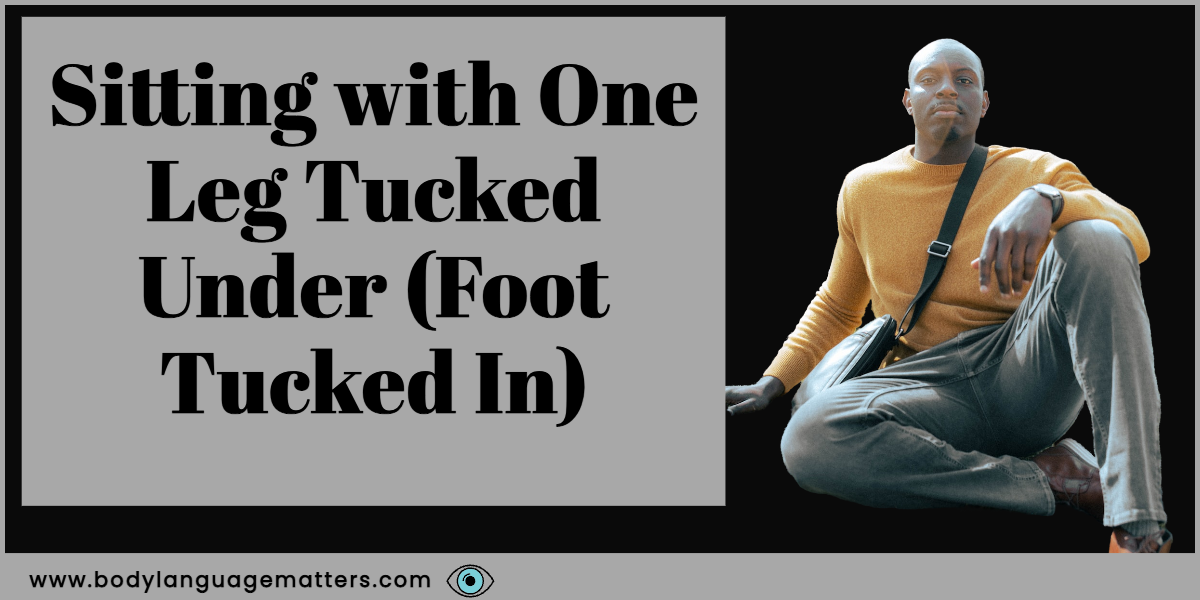Sitting with one leg tucked under is a common posture where an individual sits with one foot tucked underneath their body.
While this sitting position might feel comfortable, it’s important to be aware of the potential effects on your posture, body language, and overall health.
Body Language Interpretation ?
From a body language analyst’s perspective, sitting with one leg tucked under can convey various meanings depending on the context and individual. Here are ten possible interpretations of this posture:
- Comfort-seeking: The person might be seeking physical comfort in a potentially uncomfortable or unfamiliar environment.
- Insecurity: The individual may feel insecure or vulnerable and is unconsciously using this posture to create a sense of protection.
- Relaxation: The posture might indicate that the person is feeling relaxed and at ease in the current situation.
- Self-soothing: Sitting with one leg tucked under can be a self-soothing behavior, indicating that the person is trying to calm themselves in a stressful or anxious situation.
- Submissiveness: This posture could be a sign of submissiveness or deference, suggesting that the person feels the need to make themselves appear smaller or less threatening.
- Reserved attitude: The individual might be feeling reserved or cautious, using this posture to create a barrier between themselves and others.
- Emotional withdrawal: This posture could indicate emotional withdrawal, as the person may be physically retreating from a situation or conversation they find unpleasant or distressing.
- Informality: Sitting with one leg tucked under might be a sign of informality, suggesting that the person feels comfortable enough to adopt a casual posture in the given setting.
- Habit: Some people might adopt this posture out of habit, without any deeper psychological meaning behind it.
- Cultural influences: In certain cultures, sitting with legs apart might be considered inappropriate or impolite, especially for women. As a result, they may adopt the one-leg-tucked-under posture as an alternative.
This will also depend on the context of the situation we will explain more below.
What is Context In Body Language? ?
Context refers to the circumstances, background, or setting in which a particular event or communication takes place. It includes the environment, the people involved, their relationships, and any cultural or social factors that may influence the situation. Understanding context is crucial because it helps us accurately interpret and respond to a given situation or message.
Body language is a form of nonverbal communication that involves the use of gestures, facial expressions, posture, and other physical movements to convey information or emotions. It plays a significant role in how we interact with others, as it can provide valuable insights into a person’s thoughts, feelings, and intentions, often revealing more than their words alone.
Understanding body language is important for several reasons:
- Effective communication: By accurately interpreting body language cues, you can gain a better understanding of what others are trying to convey and respond accordingly. This enhances communication and helps avoid misunderstandings.
- Empathy and connection: Recognizing and responding to others’ body language cues can help you empathize with their emotions and establish a stronger connection, fostering better relationships both personally and professionally.
- Perception and influence: Being aware of your body language and others’ can help you manage the impressions you make and navigate social or professional situations more effectively. You can adjust your body language to project confidence, openness, or other desired qualities, thereby influencing how others perceive you.
- Cultural sensitivity: Different cultures may interpret body language cues differently. Understanding these cultural variations and being sensitive to them can help you communicate more effectively with people from diverse backgrounds, showing respect and fostering positive relationships.
Physical Effects of the Posture ?
Benefits and Drawbacks
Sitting with one foot tucked can provide temporary relief from muscle tension or discomfort. However, prolonged periods in this position may lead to muscle imbalances, joint stress, and poor circulation, potentially causing long-term knee, hip, and lower back issues.
Impact on Joints and Muscles
The uneven distribution of weight when sitting with one foot tucked can strain the knee, ankle, and pelvis, causing misalignment in the spine and hips. This can result in muscle tightness, joint pain, and even walking and running difficulties.
Sitting Habits and Health ??⚕️
Common Sitting Postures
There are various ways people sit, such as crossing their legs, sitting on their foot, or keeping their feet on the ground. Each posture has its unique implications on physical health and body language interpretation.
Proper Sitting Posture for Different Scenarios
In business meetings or formal settings, maintaining a neutral sitting posture with feet flat on the ground and knees together helps project a confident and professional image. In casual situations, sitting with legs slightly apart can convey a relaxed and approachable demeanor.
How to Improve Your Sitting Posture ?
At Home Exercises
Incorporating stretching and strengthening exercises can help improve posture and alleviate discomfort caused by sitting habits. Yoga, Pilates, and targeted stretching routines are excellent options for addressing tight muscles and promoting proper alignment.
Utilizing Ergonomic Furniture
Investing in ergonomic furniture, such as chairs with lumbar support and adjustable heights, can encourage a healthier sitting posture and reduce the risk of musculoskeletal issues.
Frequently Asked Questions
Is sitting with one leg tucked under bad for you?
Sitting with one leg tucked under is not inherently bad for you, but prolonged periods in this position can cause muscle imbalances, joint stress, and poor circulation. Over time, these issues can lead to long-term knee, hip, and lower back problems. It’s essential to maintain a variety of sitting positions and take breaks to stretch and move throughout the day.
How does sitting with one foot tucked affect body language?
Sitting with one foot tucked can convey different meanings depending on the context. In some situations, it may indicate a sense of insecurity, a desire for comfort, or a person’s emotional state. In other cases, it might be seen as a more casual or relaxed posture, especially when adopted by men in informal settings.
What are some alternative sitting postures to avoid health issues related to sitting with one leg tucked under?
To avoid health issues related to sitting with one leg tucked under, consider these alternative sitting postures:
- Sit with both feet flat on the ground, maintaining a neutral position with knees and hips at a 90-degree angle.
- Cross your legs at the ankle, keeping your knees aligned and feet firmly on the floor.
- Use a footrest to elevate your feet and promote better circulation.
What are some exercises to improve posture and counteract the effects of sitting with one foot tucked?
To improve posture and counteract the effects of sitting with one foot tucked, try incorporating these exercises:
- Yoga and Pilates exercises that focus on flexibility, balance, and core strength.
- Targeted stretching routines to alleviate tight muscles, such as hip flexor stretches, hamstring stretches, and lower back stretches.
- Strength training exercises, like squats, lunges, and deadlifts, to build strong lower body muscles and promote proper alignment.
How can ergonomic furniture help improve sitting posture?
Ergonomic furniture is specifically designed to provide support and promote proper alignment while sitting. Chairs with lumbar support, adjustable heights, and armrests can encourage a healthier sitting posture, reducing the risk of musculoskeletal issues. Ergonomic footrests can also help by elevating the feet, promoting better circulation, and maintaining proper knee and hip alignment.
Final Thoughts
Sitting with one leg tucked under might seem like a comfortable and harmless position, but it’s crucial to be aware of its potential impact on your posture, body language, and overall health.
By understanding the implications of various sitting positions and incorporating healthy habits such as regular stretching, strengthening exercises, and using ergonomic furniture, you can promote better posture and minimize the risk of long-term issues.
If you have found this article interesting you may like to read body language of the legs.

